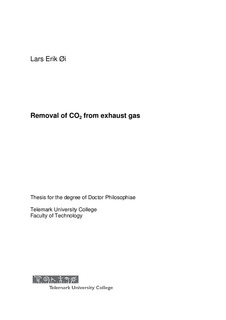| dc.contributor.author | Øi, Lars Erik | |
| dc.date.accessioned | 2012-05-30T06:55:23Z | |
| dc.date.accessioned | 2017-04-19T12:11:07Z | |
| dc.date.available | 2012-05-30T06:55:23Z | |
| dc.date.available | 2017-04-19T12:11:07Z | |
| dc.date.issued | 2012-05-30T06:55:23Z | |
| dc.identifier.citation | Øi, L.E. Removal of CO2 from exhaust gas. Doctoral dissertation, Telemark University College, 2012 | |
| dc.identifier.isbn | 978-82-7206-345-9 | |
| dc.identifier.issn | 1893-3068 | |
| dc.identifier.uri | http://hdl.handle.net/11250/2437805 | |
| dc.description | Papers 1-6 available only in the printed version of the thesis | |
| dc.description.abstract | Removal of CO2 from exhaust gas (CO2 capture) has become a very important topic the last years. There is international agreement to limit the emissions of greenhouse gases to reduce the global warming problem, and CO2 is regarded to be the most important greenhouse gas. One of the possible ways to reduce CO2 emissions to the atmosphere is to perform large scale CO2 capture and storage. There are several suggested methods for removal or capture of CO2. The most mature method is to absorb CO2 in an aqueous amine solution followed by desorption. Many calculation models for CO2 removal by absorption have been developed. These models differ in accuracy, efficiency and robustness. In the case of absorption column calculations combined with flowsheet calculations, there will often be a question whether a detailed and complex model is better than a simple and robust model. In this work, calculation methods for CO2 removal from atmospheric exhaust have been developed. To improve and validate these methods, some experimental work has also been included. Emphasis has been on calculation methods for an absorption and desorption process using MEA (monoethanolamine). One aim of the work has been to calculate cost optimum parameters in the process. Most of the calculations have been performed in combination with the process simulation tool Aspen HYSYS. Measured viscosities and densities in CO2 loaded solutions of MEA and water up to 80 ºC have been correlated. The new viscosity data of CO2 loaded MEA solutions at higher temperatures have reduced the uncertainty in the viscosity at typical absorption conditions. Pressure drop, liquid distribution and effective mass transfer area have been measured in a 0.5 m diameter column in collaboration with NTNU/SINTEF. The experiments validate the performance of structured packing in columns at typical process conditions. Murphree efficiencies have been estimated for typical CO2 absorption conditions in MEA solutions. According to calculations of absorption rates based on concentration profiles in the liquid film and approximation calculations, the deviation from pseudo first order conditions is less than 10 % for typical operation conditions below 50 ºC. Murphree efficiencies as a function of temperature for typical conditions at column top and column bottom have been calculated. These efficiencies are convenient to implement in stage to stage column calculation models. On the assumptions that pseudo first order conditions are met and the temperature at a stage is approximately constant, the accuracy in calculating overall CO2 removal efficiency using Murphree efficiencies is the same as for more rigorous calculations. A CO2 removal process from exhaust gas from a natural gas based power plant has been calculated in Aspen HYSYS. Total CO2 removal grade and heat consumption have been calculated as a function of circulation rate, absorber temperature and other parameters. Simulations of the absorber have also been performed with Aspen Plus using both constant Murphree efficiencies and rate-based simulation and all the simulations give similar trends as a function of the varying parameters. Aspen HYSYS calculations using varying Murphree efficiencies give similar temperature profiles compared to Aspen Plus rate-based calculations. The process simulation calculations have also included split-stream configurations. A splitstream process using MEA with a heat consumption of only 3.0 GJ/ton CO2 removed has been calculated in Aspen HYSYS compared to approximately 4.0 GJ/ton CO2 for a standard process. However, cost estimation calculations show that it is uncertain whether a splitstream process is more economical than a standard process. Equipment dimensioning and cost estimation have also been included in the calculations. From a series of calculations, a cost optimum can be calculated. Optimum gas inlet temperature to the absorber has been calculated to values between 33 and 35 ºC which is lower than traditionally assumed values. Optimum minimum temperature difference in the main amine/amine heat exchanger has been calculated to values between 12 and 19 ºC which is higher than traditionally assumed. This optimum is very dependent on the ratio between investment and energy cost. Optimum rich loading has been calculated to 0.47 mol CO2/mol MEA which is similar to earlier optimization calculations. Automatic calculation of these optimums is possible when using e.g. Aspen HYSYS with specified Murphree efficiencies. | |
| dc.language.iso | eng | |
| dc.publisher | Telemark University College | |
| dc.relation.ispartofseries | Doctoral dissertations at TUC;2012:2 | |
| dc.subject | CO2 | |
| dc.subject | exhaust gas | |
| dc.subject | CO2 capture | |
| dc.title | Removal of CO2 from exhaust gas | |
| dc.type | Doctoral thesis | |
| dc.type | Peer reviewed | |
| dc.description.version | Published version | |
| dc.rights.holder | © Copyright The Author. All rights reserved | |
| dc.subject.nsi | 610 | no |
